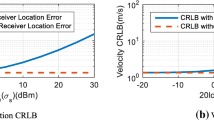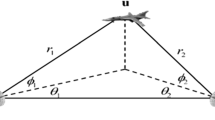Abstract
High-precision position awareness is essential to ubiquitous wireless networks, which can provide real-time position information and abundant status information for numerous practical applications. However, It is a challenge to obtain accurate position estimation utilizing traditional onefold parameter estimation, especially for the accurate position estimation of moving radiation source in the presence of receiver position errors. In this work, we developed an Improved Taylor Series estimation method in three-dimensional positioning scene, in which time difference of arrival (TDOA) and frequency difference of arrival (FDOA) are used to estimate the position and velocity of the target, and the position of the receiver is iteratively updated to reduce the influence of the receiver position errors. The closed-form expressions of Cramer–Rao low bound (CRLB) based on joint TDOA and FDOA positioning with receiver position errors are derived. In the simulation, CRLB with and without receiver position errors are evaluated to illustrate the influence of the receiver position errors on the positioning performance. Theory analysis and simulation results show that the proposed algorithm has lower complexity, smaller RMSE and better positioning performance than multidimensional scaling (W-MDS) algorithm, constrained total least squares algorithm and two-step weighted least squares algorithm for both near-field and far-field emitters.







Similar content being viewed by others
Data availability
Data sharing not applicable to this article as no datasets were generated or analysed during the current study.
References
Havyarimana, V., Xiao, Z., Semong, T., Bai, J., Chen, H., & Jiao, L. (2023). Achieving reliable intervehicle positioning based on redheffer weighted least squares model under Multi-GNSS outages. IEEE Transactions on Cybernetics, 53(2), 1039–1050.
Kang, Y., Wang, Q., Wang, J., & Chen, R. (2019). A high-accuracy TOA-based localization method without time synchronization in a three-dimensional space. IEEE Transactions on Industrial Informatics, 15(1), 173–182.
Xiao, Z., Chen, Y., Alazab, M., & Chen, H. (2022). Trajectory data acquisition via private car positioning based on tightly-coupled GPS/OBD integration in urban environments. IEEE Transactions on Intelligent Transportation Systems, 23(7), 9680–9691.
Mai, Z., Xiong, H., Yang, G., Zhu, W., He, F., Bian, R., & Li, Y. (2021). Mobile target localization and tracking techniques in harsh environment utilizing adaptive multi-modal data fusion. IET Communications, 15(5), 736–747.
Yan, K., Wu, H. C., Fang, S. H., Wang, C., Li, S., & Zhang, L. (2020). Indoor femtocell interference localization. IEEE Transactions on Wireless Communications, 19(8), 5176–5187.
Li, Y., & Yan, K. (2021). Indoor localization based on radio and sensor measurements. IEEE Sensors Journal, 21(22), 25 090-25 097.
Yan, K., Xia, Z., Wu, S., Liu, X., & Fang, G. (2022). Through-floor vital sign imaging for trapped persons based on optimized 2-D UWB life-detection radar deployment. IEEE Antennas and Wireless Propagation Letters, 21(1), 39–43.
Zhong, W., Xiong, H., Hua, Y., Shah, D. H., Liao, Z., & Xu, Y. (2024). TSFANet: Temporal-spatial feature aggregation network for GNSS jamming recognition. IEEE Transactions on Instrumentation and Measurement, 99, 1–13.
Xiong, H., Bian, R., Li, Y., Du, Z., & Mai, Z. (2020). Fault-tolerant GNSS/SINS/DVL/CNS integrated navigation and positioning mechanism based on adaptive information sharing factors. IEEE Systems Journal, 14(3), 3744–3754.
Havyarimana, V., Xiao, Z., Bizimana, P. C., Hanyurwimfura, D., & Jiang, H. (2021). Toward accurate intervehicle positioning based on GNSS pseudorange measurements under non-gaussian generalized errors. IEEE Transactions on Instrumentation and Measurement, 70, 1–12.
Shu, Y., Xu, P., Niu, X., Chen, Q., Qiao, L., & Liu, J. (2022). High-rate attitude determination of moving vehicles with GNSS: GPS, BDS, GLONASS, and Galileo. IEEE Transactions on Instrumentation Measurement, 71, 1–13.
Zhang, H., Xiong, H., Hao, S., Yang, G., Wang, M., & Chen, Q. (2024). A novel multidimensional hybrid position compensation method for INS/GPS integrated navigation systems during GPS outages. IEEE Sensors Journal, 24(1), 962–974.
Xiong, H., Tang, J., Xu, H., Zhang, W., & Du, Z. (2018). A robust single GPS navigation and positioning algorithm based on strong tracking filtering. IEEE Sensors Journal, 18(1), 290–298.
Havyarimana, V., Hanyurwimfura, D., Nsengiyumva, P., & Xiao, Z. (2018). A novel hybrid approach based-SRG model for vehicle position prediction in multi-GPS outage conditions. Information Fusion, 41, 1–8.
Havyarimana, V., Xiao, Z., Sibomana, A., Wu, D., & Bai, J. (2020). A fusion framework based on sparse Gaussian–Wigner prediction for vehicle localization using GDOP of GPS satellites. IEEE Transactions on Intelligent Transportation Systems, 21(2), 680–689.
He, Q., Hu, J., Blum, R. S., & Wu, Y. (2016). Generalized Cramer-Rao bound for joint estimation of target position and velocity for active and passive radar networks. IEEE Transactions on Signal Processing, 64(8), 2078–2089.
Ma, F., Liu, Z., & Guo, F. (2020). Distributed direct position determination. IEEE Transactions on Vehicular Technology, 69(11), 14 007-14 012.
Sun, Y., Ho, K. C., & Wan, Q. (2019). Solution and analysis of TDOA localization of a near or distant source in closed form. IEEE Transactions on Signal Processing, 67(2), 320–335.
Xiong, H., Peng, M., Gong, S., & Du, Z. (2018). A novel hybrid RSS and TOA positioning algorithm for multi-objective cooperative wireless sensor networks. IEEE Sensors Journal, 18(22), 9343–9351.
Ma, F., Liu, Z., & Guo, F. (2019). Direct position determination in asynchronous sensor networks. IEEE Transactions on Vehicular Technology, 68(9), 8790–8803.
Al Sadoon, M. . A. . G., Asif, R., Al Yasir, Y. . I. . A., Abd Alhameed, R. . A., & Excell, P. . S. (2020). AOA localization for vehicle-tracking systems using a dual-band sensor array. IEEE Transactions on Antennas and Propagation, 68(8), 6330–6345.
Li, Y. Y., Qi, G. Q., & Sheng, A. D. (2018). Performance metric on the best achievable accuracy for hybrid TOA/AOA target localization. IEEE Communications Letters, 22(7), 1474–1477.
Cao, H., Chan, Y. T., & So, H. C. (2020). Compressive TDOA estimation: Cramér-Rao bound and incoherent processing. IEEE Transactions on Aerospace and Electronic Systems, 56(4), 3326–3331.
Pei, Y., Li, X., Yang, L., & Guo, F. (2023). A closed-form solution for source localization using FDOA measurements only. IEEE Communications Letters, 27(1), 115–119.
Xiong, H., Peng, M., Zhu, K., Yang, Y., Du, Z., Xu, H., & Gong, S. (2018). Efficient bias reduction approach of time-of-flight-based wireless localization networks in NLOS states. IET Radar, Sonar & Navigation, 12(11), 1353–1360.
Wang, Y., & Ho, K. C. (2017). TDOA positioning irrespective of source range. IEEE Transactions on Signal Processing, 65(6), 1447–1460.
Pine, K. C., Pine, S., & Cheney, M. (2021). The geometry of far-field passive source localization with TDOA and FDOA. IEEE Transactions on Aerospace and Electronic Systems, 57(6), 3782–3790.
Qu, X., Xie, L., & Tan, W. (2017). Iterative constrained weighted least squares source localization using TDOA and FDOA measurements. IEEE Transactions on Signal Processing, 65(15), 3990–4003.
Ho, K. C., & Xu, W. (2004). An accurate algebraic solution for moving source location using TDOA and FDOA measurements. IEEE Transactions on Signal Processing, 52(9), 2453–2463.
Wei, H. W., Peng, R., Wan, Q., Chen, Z. X., & Ye, S. F. (2010). Multidimensional scaling analysis for passive moving target localization with TDOA and FDOA measurements. IEEE Transactions on Signal Processing, 58(3), 1677–1688.
Noroozi, A., Oveis, A. H., Hosseini, S. M., & Sebt, M. A. (2018). Improved algebraic solution for source localization from TDOA and FDOA measurements. IEEE Wireless Communications Letters, 7(3), 352–355.
Wang, Y., & Wu, Y. (2017). An efficient semidefinite relaxation algorithm for moving source localization using TDOA and FDOA measurements. IEEE Communications Letters, 21(1), 80–83.
Zhang, X., Wang, F., Li, H., & Himed, B. (2021). Maximum likelihood and IRLS based moving source localization with distributed sensors. IEEE Transactions on Aerospace and Electronic Systems, 57(1), 448–461.
Congfeng, L., Jinwei, Y., & Juan, S. (2020). Direct solution for fixed source location using well-posed TDOA and FDOA measurements. Journal of Systems Engineering and Electronics, 31(4), 666–673.
Ho, K. C. (2012). Bias reduction for an explicit solution of source localization using TDOA. IEEE Transactions on Signal Processing, 60(5), 2101–2114.
Yang, B., Li, J., Shao, Z., & Zhang, H. (2023). Self-supervised deep location and ranging error correction for UWB localization. IEEE Sensors Journal, 23(9), 9549–9559.
Ho, K. C., Lu, X., & Kovavisaruch, L. (2007). Source localization using TDOA and FDOA measurements in the presence of receiver location errors: Analysis and solution. IEEE Transactions on Signal Processing, 55(2), 684–696.
Noroozi, A., Sebt, M. A., & Oveis, A. H. (2019). Efficient weighted least squares estimator for moving target localization in distributed MIMO radar with location uncertainties. IEEE Systems Journal, 13(4), 4454–4463.
Yu, H., Gao, J., & Huang, G. (2012). Constrained total least-squares localisation algorithm using time difference of arrival and frequency difference of arrival measurements with sensor location uncertainties. IET Radar, Sonar and Navigation, 6(9), 891–899.
Mao, Z., Su, H., He, B., & Jing, X. (2021). Moving source localization in passive sensor network with location uncertainty. IEEE Signal Processing Letters, 28, 823–827.
Wang, W., Bai, P., Wang, Y., Liang, X., & Zhang, J. (2019). Optimal sensor deployment and velocity configuration with hybrid TDOA and FDOA measurements. IEEE Access, 7, 109181–109194.
Wang, D., Zhang, P., Yang, Z., Wei, F., & Wang, C. (2020). A novel estimator for TDOA and FDOA positioning of multiple disjoint sources in the presence of calibration emitters. IEEE Access, 8, 1613–1643.
Zou, Y., & Liu, H. (2020). TDOA localization with unknown signal propagation speed and sensor position errors. IEEE Communications Letters, 24(5), 1024–1027.
Acknowledgements
The authors would like to thank the editors and the anonymous reviewers.
Funding
This work was supported in part by the Natural Science Foundation of Guangdong Province under Grant 2022A1515011975, in part by Shenzhen Fundamental Research Program under grant JCYJ20220530141017040, in part by the Natural Science Foundation of Shandong Province under grants ZR2022LZH005, in part by the Science and Technology Program in Qingdao under Grants 22-3-7-CSPZ-2-nsh.
Author information
Authors and Affiliations
Contributions
YZ and FH designed the method and wrote the main part of the manuscript, HZ designed the experiments and contributed to the writing of the manuscript, HY conducted the complexity analysis of the algorithm, ZD and ZX made grammar modifications to the manuscript. All authors reviewed the manuscript.
Corresponding author
Additional information
Publisher's Note
Springer Nature remains neutral with regard to jurisdictional claims in published maps and institutional affiliations.
Rights and permissions
Springer Nature or its licensor (e.g. a society or other partner) holds exclusive rights to this article under a publishing agreement with the author(s) or other rightsholder(s); author self-archiving of the accepted manuscript version of this article is solely governed by the terms of such publishing agreement and applicable law.
About this article
Cite this article
Zhang, Y., He, F., Zhang, H. et al. TDOA and FDOA Hybrid Positioning of Mobile Radiation Source with Receiver Position Errors. Wireless Pers Commun 137, 199–220 (2024). https://doi.org/10.1007/s11277-024-11387-7
Accepted:
Published:
Issue Date:
DOI: https://doi.org/10.1007/s11277-024-11387-7




